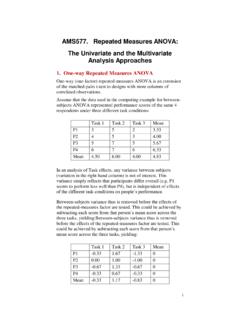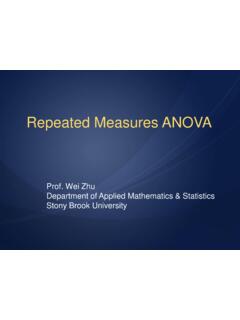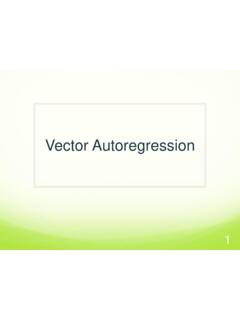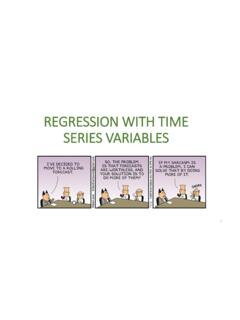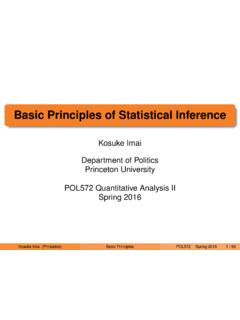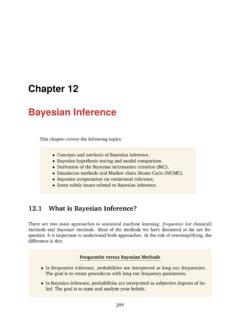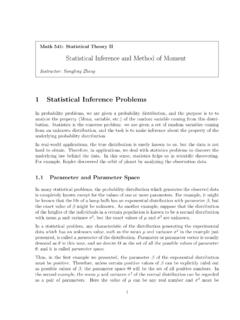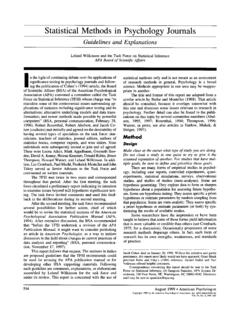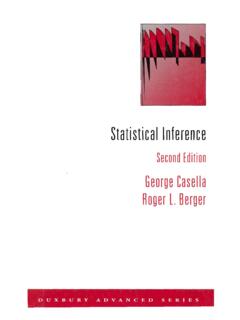Transcription of Solutions Manual for Statistical Inference, Second Edition
1 Solutions Manual forStatistical inference , Second EditionGeorge CasellaUniversity of FloridaRoger L. BergerNorth Carolina State UniversityDamaris SantanaUniversity of Florida0-2 Solutions Manual for Statistical inference When I hear you give your reasons, I remarked, the thing always appears to me to be soridiculously simple that I could easily do it myself, though at each successive instance of yourreasoning I am baffled until you explain your process. Dr. Watson to Sherlock HolmesA Scandal in DescriptionThis Solutions Manual contains Solutions forall odd numbered problemsplus a large number ofsolutions for even numbered problems. Of the 624 exercises inStatistical inference , Second Edition ,this Manual gives Solutions for 484 (78%) of them. There is an obtuse pattern as to which solutionswere included in this Manual .
2 We assembled all of the Solutions that we had from the first Edition ,and filled in so that all odd-numbered problems were done. In the passage from the first to thesecond Edition , problems were shuffled with no attention paid to numbering (hence no attentionpaid to minimize the new effort), but rather we tried to put the problems in logical major change from the first Edition is the use of the computer, both symbolically throughMathematicatmand numerically usingR. Some Solutions are given as code in either of these lan-guages. Mathematicatmcan be purchased from Wolfram Research, andRis a free download is a detailed listing of the Solutions Number of Exercises Number of SolutionsMissing1555126,30,36,422403734, 38,40350424,6,10,20,30,32,34,36465528,14 ,22,28,36,4048,50,52,56,58,60,62569462,4 ,12,14,26,28all even problems from 36 68643358,16,26,28,34,36,38,42766524,14,1 6,28,30,32,34,36,42,54,58,60,62,64858513 6,40,46,48,52,56,58958412,8,10,20,22,24, 26,28,3032,38,40,42,44,50,54,56104826all even problems except 4 and 321141354,20,22,24,26,40123116all even AcknowledgementMany people contributed to the assembly of this Solutions Manual .
3 We again thank all of thosewho contributed Solutions to the first Edition many problems have carried over into the secondedition. Moreover, throughout the years a number of people have been in constant touch with us,contributing to both the presentations and Solutions . We apologize in advance for those we forget tomention, and we especially thank Jay Beder, Yong Sung Joo, Michael Perlman, Rob Strawderman,and Tom Wehrly. Thank you all for your , as we said the first time around, although we have benefited greatly from the assistance andACKNOWLEDGEMENT0-3comments of others in the assembly of this Manual , we are responsible for its ultimate this end, we have tried our best but, as a wise man once said, You pays your money and youtakes your chances. George CasellaRoger L. BergerDamaris SantanaDecember, 2001 Chapter 1 Probability Theory If any little problem comes your way, I shall be happy, if I can, to give you a hint or two asto its solution.
4 SherlockHolmesThe Adventure of the Three a. Each sample point describes the result of the toss (H or T) for each of the four tosses. So,for example THTT denotes T on 1st, H on 2nd, T on 3rd and T on 4th. There are 24= 16such sample The number of damaged leaves is a nonnegative integer. So we might useS={0,1,2, ..}.c. We might observe fractions of an hour. So we might useS={t:t 0}, that is, the halfinfinite interval [0, ).d. Suppose we weigh the rats in ounces. The weight must be greater than zero so we might useS= (0, ). If we know no 10-day-old rat weighs more than 100 oz., we could useS= (0,100].e. Ifnis the number of items in the shipment, thenS={0/n,1/n, .. ,1}. For each of these equalities, you must show containment in both A\B x Aandx / B x Aandx / A B x A\(A B). Also,x Aandx / B x Aandx Bc x A Supposex B.
5 Then eitherx Aorx Ac. Ifx A, thenx B A, and, hencex (B A) (B Ac). ThusB (B A) (B Ac). Now supposex (B A) (B Ac).Then eitherx (B A) orx (B Ac). Ifx (B A), thenx B. Ifx (B Ac),thenx B. Thus (B A) (B Ac) B. Since the containment goes both ways, we haveB= (B A) (B Ac). (Note, a more straightforward argument for this part simply usesthe Distributive Law to state that (B A) (B Ac) =B (A Ac) =B S=B.)c. Similar to part a).d. From part b).A B=A [(B A) (B Ac)] =A (B A) A (B Ac) =A [A (B Ac)] =A (B Ac). A B x Aorx B x B Ax A B x Aandx B x B A (B C) x Aorx B C x A Borx C x (A B) C.(It can similarly be shown thatA (B C) = (A C) B.)x A (B C) x Aandx Bandx C x (A B) (A B)c x / Aorx / B x Acandx Bc x Ac Bcx (A B)c x / A B x / Aandx / B x Acorx Bc x Ac a. AorBor both isA B. From Theorem we haveP(A B) =P(A)+P(B) P(A B).
6 1-2 Solutions Manual for Statistical Inferenceb. AorBbut not both is (A Bc) (B Ac). Thus we haveP((A Bc) (B Ac)) =P(A Bc) +P(B Ac)(disjoint union)= [P(A) P(A B)] + [P(B) P(A B)] ( )=P(A) +P(B) 2P(A B).c. At least one ofAorB isA B. So we get the same answer as in a).d. At most one ofAorB is (A B)c, andP((A B)c) = 1 P(A B). B C={a birth results in identical twins that are female} (A B C) =190 13 (1 u)(1 w), p1=u(1 w) +w(1 u), p2=uw,p0=p2 u+w= 1p1=p2 uw= 1 two equations implyu(1 u) = 1/3, which has no solution in the real numbers. Thus,the probability assignment is not (scoringipoints) ={1 r2 Aifi= 0 r2A[(6 i)2 (5 i)252]ifi= 1, .. , (scoringipoints|board is hit) =P(scoringipoints board is hit)P(board is hit)P(board is hit) = r2AP(scoringipoints board is hit) = r2A[(6 i)2 (5 i)252]i= 1.}
7 , ,P(scoringipoints|board is hit) =(6 i)2 (5 i)252i= 1, .. ,5which is exactly the probability distribution of Example (scoring exactlyipoints) =P(inside circlei) P(inside circlei+ 1). Circleihas radius(6 i)r/5, soP(sscoring exactlyipoints) = (6 i)2r252 r2 ((6 (i+ 1)))2r252 r2=(6 i)2 (5 i) Expanding the squares in part a) we findP(scoring exactlyipoints) =11 2i25, which isdecreasing LetP(i) =11 2i25. Sincei 5,P(i) 0 for (S) =P(hitting the dartboard) = 1 bydefinition. Lastly,P(i j) = area ofiring + area ofjring =P(i) +P(j). a. Supposex ( A )c, by the definition of complementx6 A , that isx6 A for all . Thereforex Ac for all . Thusx Ac and, by the definition of intersectionx Ac for all . By the definition of complementx6 A for all . Thereforex6 A . Thusx ( A ) Edition1-3b.
8 Supposex ( A )c, by the definition of complementx6 ( A ). Thereforex6 A forsome . Thereforex Ac for some . Thusx Ac and, by the definition ofunion,x Ac for some . Thereforex6 A for some . Thereforex6 A . Thusx ( A ) ForA1, .. , An(i)(n i=1Ai)c=n i=1 Aci(ii)(n i=1Ai)c=n i=1 AciProof of (i): Ifx ( Ai)c, thenx / Ai. That impliesx / Aifor anyi, sox Acifor everyiandx of (ii): Ifx ( Ai)c, thenx / Ai. That impliesx Acifor somei, sox We must verify each of the three properties in Definition (1) The empty set { , S}. Thus B. (2) c=S BandSc= B. (3) S=S (1) The empty set is a subset of any set, in particular, S. Thus B. (2) IfA B,thenA S. By the definition of complementation,Acis also a subset ofS, and, hence,Ac B. (3) IfA1, A2, .. B, then, for eachi, Ai S.
9 By the definition of union, Ai , Ai LetB1andB2be the two sigma algebras. (1) B1and B2sinceB1andB2aresigma algebras. Thus B1 B2. (2) IfA B1 B2, thenA B1andA B2. SinceB1andB2are both sigma algebraAc B1andAc B2. ThereforeAc B1 B2. (3) IfA1, A2, .. B1 B2, thenA1, A2, .. B1andA1, A2, .. B2. Therefore, sinceB1andB2are both sigma algebra, i=1Ai B1and i=1Ai B2. Thus i=1Ai B1 First writeP( i=1Ai)=P(n i=1Ai i=n+1Ai)=P(n i=1Ai)+P( i=n+1Ai)(Ais are disjoint)=n i=1P(Ai) +P( i=n+1Ai)(finite additivity)Now defineBk= i=kAi. Note thatBk+1 BkandBk ask . (Otherwise the sumof the probabilities would be infinite.) ThusP( i=1Ai)= limn P( i=1Ai)= limn [n i=1P(Ai) +P(Bn+1)]= i=1P(Ai). IfAandBare disjoint,P(A B) =P(A) +P(B) =13+34=1312, which is impossible. Moregenerally, ifAandBare disjoint, thenA BcandP(A) P(Bc).
10 But hereP(A)> P(Bc),soAandBcannot be IfS={s1, .. , sn}, then any subset ofScan be constructed by either including or excludingsi, for eachi. Thus there are 2npossible Proof by induction. The proof fork= 2 is given after Theorem Assume true fork, thatis, the entire job can be done inn1 n2 nkways. Fork+ 1, thek+ 1th task can bedone innk+1ways, and for each one of these ways we can complete the job by performing1-4 Solutions Manual for Statistical Inferencethe remainingktasks. Thus for each of thenk+1we haven1 n2 nkways of com-pleting the job by the induction hypothesis. Thus, the number of ways we can do the job is(1 (n1 n2 nk)) + + (1 (n1 n2 nk)) nk+1terms=n1 n2 nk nk+ a) 263. b) 263+ 262. c) 264+ 263+ There are(n2)=n(n 1)/2 pieces on which the two numbers do not match.
